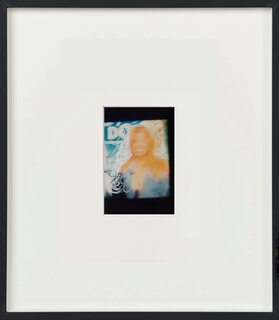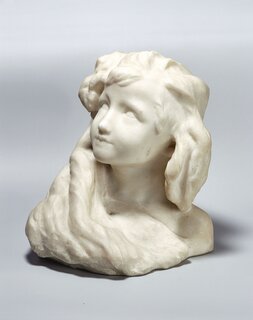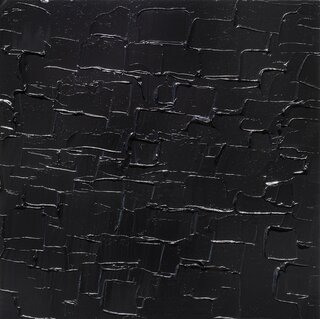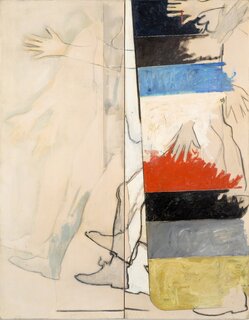
"Mario kept telling me about Rauschenberg, Jasper Johns… America was like a dream. One day I said to him: ‘My cousin lives in New York …’ We decided to go there. That was in December 1963; President Kennedy had only just been shot. After his return from New York, Schifano became a pole of urban cultural life. The mid-60s were an extremely creative phase. Schifano produced artworks that offered an autonomous model for Roman or even European Pop Art.
—Anita Pallenberg, 2001
Mario Schifano was one of the leading members of the avant-garde Scuola di Piazza del Popolo in Rome. He is renowned for his development of a distinctly Italian approach to Pop art, composing monochrome paintings that feature numbers, letters, road signs, and trademarks for corporations such as Esso and Coca-Cola. He first received significant acclaim for his contribution to the 1960 exhibition Cinque pittori romani: Angeli, Festa, Lo Savio, Schifano, Uncini, curated by Pierre Restany at Rome’s Galleria La Salita, and had his first solo exhibition in 1961 at Galleria La Tartaruga in Rome, following which he signed an exclusive contract with the gallerist Ileana Sonnabend. In 1962 he first visited the United States, where he met artists and writers including Jasper Johns, Mark Rothko, Andy Warhol, Frank O’Hara, and Gregory Corso. The same year, his works were included in the seminal New Realists exhibition at the Sidney Janis Gallery in New York.
For the 1964 Venice Biennale, Schifano exhibited two works, Beebe’s Garden Summer Morning (1964) and When I Remember Giacomo Balla–New York–1964
(1964), in the central pavilion as part of The Latest Trends exhibition curated by Maurizio Calvesi. While many of the exhibiting Italian artists appropriated widespread commercial signs and symbols, Schifano was in the process distancing himself from the Pop category and some aspects of his earlier work. He began aligning his work to the ‘first wave’ of the Italian avant-garde, the Futurists, and in particular to Giacomo Balla. In 1963 the art historian Maurizio Calvesi gave Schifano a catalogue of an exhibition on Futurism at Galleria Civica d’Arte Moderna e Contemporanea in Turin curated by Enrico Crispolti. Founded in 1909 by the Italian poet Filippo Tommaso Marinetti, Futurism glorified modern industry and technology. Denouncing artistic traditions, members of the movement used Neo-Impressionist and Cubist styles to depict a radically contemporary world that emphasized dynamism and speed. By naming Balla in the title of his 1964 work, Schifano tied himself to this lineage, which insisted on the vital continuity between past and present and a more consistently painterly approach to subject-matter. Ultimo Autunno (L'amico G.F.) was painted shortly after Schifano’s presentation at the Biennale. The painting is composed across two joined canvasses. The left-hand canvas is largely achromatic, with marks that delineate hands, arms, and legs; the right-hand canvas is banded with horizontal blocks of black, blue, red, yellow, and white. The repeating limbs are fragmented from their bodies, which are largely hidden by the streaks of colour. The overlapping arms and legs mimic the kineticism of a moving figure, recalling such early twentieth-century avant-garde works as Balla’s Dinamismo di un cane al guinzaglio (1912) and Marcel Duchamp’s Nude Descending a Staircase (1912). Ultimo Autunno also seeks other visual correlations, weaving references to the art-historical past with more recent ones. The loose limbs and striped portion of the canvas echo compositional elements of Jasper Johns’s Watchman (1964). Indeed, Schifano had befriended Johns and had been inspired by the American artist during his time in New York.
The 1964 Venice Biennale designated a shift in cultural authority in the international art world. That year, Robert Rauschenberg became the first American to win the Golden Lion award, signalling a move away from the dominance of European modernism toward post-war American Pop sensibilities. Schifano’s output was deeply shaped by the ideas that characterized both aesthetic modes. Ultimo Autunno exemplifies an amalgam of Balla’s Italian Futurism and the emphasis on quotidian imagery and iconography found in the work of such contemporary American artists as Johns and Rauschenberg. The present work also prefigures Schifano’s experimentation with Perspex and TV screens, situating his work in conversation with the concurrent Arte Povera movement, whose artists created works that materially reflected the destructive aftermath of World War II as well as the social and economic changes that followed. Schifano’s Ultimo Autunno encompasses Italy’s artistic traditions and innovations, looking forward to a global future in a gesture similar to that of his avant-garde predecessors. "









